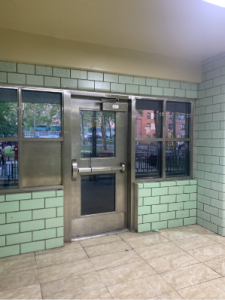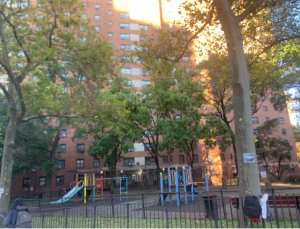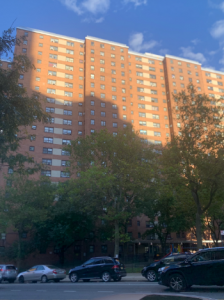By Staff Writer Emily Ekshian
GRANT HOUSES, MORNINGSIDE HEIGHTS – Is the government truly concerned, or are they simply clustering low income communities together to keep them immobile, and in one space?
The New York City Housing Authority (NYCHA), has a profound legacy as the country’s first government – sponsored public housing agency. Established in 1935, the 334 housing developments provided by NYCHA include apartment units, houses and shared small building units across New York City’s five boroughs. And the agency’s core mission is to provide decent, safe, and affordable housing primarily for low income New Yorkers, though tenants at the Grant Houses would disagree.
Casually leaning on an NYPD smart car on the collapsed curbside area facing 50 La Salle St, Officer Kang guards the Grant Public housing apartment park, where a shooting occurred down the street just about a week ago. “We’re close to the bottom here,” he says. “Bad living conditions, it tends to get crowded often, and most people are on some sort of social benefits, like food stamps.” Coupled with housing efforts, NYCHA has helped residents access social services, like the City’s Cash Assistance Program, which gives eligible individuals access to Medicaid and food stamps.

Overall, NYCHA’s public housing developments represent 7.7 % of the city’s rental apartments, and houses 4.3 % of the city’s population. Though, safety and sanitary conditions happen to be an ongoing challenge for NYCHA, as many of the public housing complexes throughout the City are plagued with leaks, molds and insects. Maintenance issues, as well as stabbings and shootings, drug trade, vandalism, and infrastructural inefficiency like late fixes, characterize the lives of most NYCHA residents living in Harlem.
“Aside from a few bad apples, most people just want love, friendship after going through the bad stuff,” says Officer Kang, hopeful of the housing community’s social mobility. Though, years of unstable housing conditions have sparked mass controversy among its 500,000 residents.
Elijah Slocum, a local high schooler, living in the Grant Houses public housing complex on 55 on Law Salle St., shares that housing conditions “… depend on you and how you take care of your house. But the elevator, it barely works. Pipes in the buildings leak.” Elijah says NYCHA is slow to respond in maintaining the building, even with multiple requests from residents to improve security and sanitary living; “when I had a leak in my bathroom, they took almost a month to fix it.” The Grant Houses are located on 123rd street and La Salle Street to 125th street in Morningside Heights of the Manhattan borough. The houses consist of nine buildings, housing an estimated 4,500 residents, as a part of the total 84 NYCHA developments in Manhattan. Safety remains a crucial matter, with teenage shootings in local courtyards, and the elderly stuck in inoperative elevators according

to current tenants and community members.
Slocum lives with his grandparents, and says that conditions could get dangerous in the area especially at the residential park; “I wouldn’t recommend hanging out here all the time. There is barely any security in the building.” These conditions pose a threat to the 61,500 elderly aged 65 and older that live in NYCHA housing. Older residents are the fastest growing age group among NYCHA’s population, due to the rising cost of living in New York City. Residents from surrounding Grant houses express that conditions are “horrible, with no guards anywhere!”
In 2018, a federal lawsuit was filed against NYCHA requesting an independent monitor to oversee NYCHA operations. According to investigations, NYCHA failed to provide residents in housing all over the city with basic utilities like heat, electricity and hot water. Lead paint was also a concern for many residents. Additionally, NYCHA was training its workers to deceive inspectors under oversight sessions. Ultimately, the lawsuit was resolved with NYCHA agreeing to oversight on operations, by federal monitor Bart Schwartz. In the most recent quarterly report, Schwartz exposes mass garbage displacement posing an issue for sanitation almost amongst all NYCHA developments, in addition to repeated instances of rodent burrows and severe mold growth.
Numerous studies show that neighborhoods with higher poverty rates tend to have higher rates of violent crime. And indicators, like job access, immigration status, and residential instability can either block or expand people’s opportunities for upward mobility. Forty – nine percent of NYCHA’s residents have very low income. These households make an annual income below 100% of the federal poverty level, constituting less than $10,830 annually, per family. Economic insecurity is highest for single parent families; there is great disparity among Black and Latinx families, with child poverty between 46% and 56%.

Local Social Worker Robin Carbin has faith in the betterment of the Grant Houses community. He says, “ [I] build relationships, mentor teenagers and children. I also do home – to – home visits with my clients and they’re valuable,” he says. “My job doesn’t feel like a job.” Carbin says ” I Look at them as family, and they accept me as theirs.” Though, he shares that circumstances are unmanaged, as the infrastructure is old, and the area holds safety uncertainty.
Historically, public housing in the city has suffered from a plethora of social issues constituting increased homelessness, gang and drug violence, as well as, a rise in sexually transmitted diseases and teen pregnancy in associated communities. Income disparities also perpetuate dire social circumstances, like shootings, stabbings and theft.

Sekou, a student at LaGuardia community college studying software development and programming, is another resident at the Grant Houses 55 on La Salle St., where he lives with his partner and 4 year old son. “I just passed by teenagers with weapons on them,” he says vigilantly. According to Sekou, and other members of the public housing community specific to Harlem, those possessing weapons tend to be 13 – 15 year old males, with older males in their 40s serving time in prison. “Sometimes, I’ll be in my room during broad daylight, and I’ll hear gunshots, or windows shattering,” he says. “The lock for the main door of the building doesn’t even work properly, so anyone could enter the building, ” says Sekou furiously, and worried.
NYPD data shows that while NYCHA’s 400,000 residents make up only 4% of New York City’s population, an estimated 20% of violent crime, prominently shootings, occur within 100 feet of public housing. Sekou proceeds to talk about the shooting that occurred Wednesday midnight, among teenagers at another Grant House site down the street. The residential park was at 1305 Amsterdam, near a public day care center. “Best way to stay safe out here is to mind your own business. Don’t bother anyone!” he said.
Photos
All photos by Emily Ekshian
